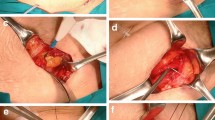Abstract
The use of a caudal block in laparoscopic surgery in children is limited to minor procedures like inguinal hernia repair, and intravenous opioids remain the analgesic modality of choice in major laparoscopic surgery. However, a caudal block is frequently performed at our institute even for laparoscopic surgery. Therefore, we planned to evaluate the analgesic efficacy of caudal bupivacaine and morphine in major laparoscopic surgery as compared to intravenous opioids. Our hypothesis was that a single-shot caudal block would increase the duration of analgesia and minimize the hemodynamic response to pneumoperitoneum. After institutional ethics committee clearance, data were collected for 65 ASA I–II children aged 6 months to 12 years who underwent laparoscopic surgery in the last 14 months. Demographic, surgical, and perioperative anesthetic and analgesic data were noted and analyzed. Twenty-four children received a caudal block with 0.25 % bupivacaine (1–1.25 ml/kg) with morphine (30–50 mcg/kg). In the caudal group, the time to first analgesic request was increased (165 vs. 45 min; p = 0.00) and tachycardia response to port site incision was less observed (33 vs. 63 % children; p = 0.019). Hemodynamic response to pneumoperitoneum was equal in both of the groups. Single-shot caudal injection of local anesthetic with morphine reduces port site skin incision response and increases the duration of postoperative analgesia but fails to prevent hemodynamic response to pneumoperitoneum.
Similar content being viewed by others
References
Gans S, Berci G. Advances in endoscopy of infants and children. J Pediatr Surg. 1971;6:199–234.
Yeh CN, Tsai CY, Cheng CT, Wang SY, Liu YY, Chiang KC, Hsieh FJ, Lin CC, Jan YY, Chen MF. Pain relief from combined wound and intraperitoneal local anesthesia for patients who undergo laparoscopic cholecystectomy. BMC Surg. 2014;14:28.
Maitra S, Baidya DK, Khanna P, Ray BR, Panda SS, Bajpai M. Acute perioperative pain in neonates: an evidence-based review of neurophysiology and management. Acta Anaesthesiol Taiwan. 2014;52:30–7.
Liu Y, Seipel C, Lopez ME, Nuchtern JG, Brandt ML, Fallon SC, Manyang PA, Tjia IM, Baijal RG, Watcha MF. A retrospective study of multimodal analgesic treatment after laparoscopic appendectomy in children. Paediatr Anaesth. 2013;23:1187–92.
Beyaz SG, Tokgöz O, Tüfek A. Caudal epidural block in children and infants: retrospective analysis of 2088 cases. Ann Saudi Med. 2011;31:494–7.
Golladay S, Hutter S, Koehn E, Hunt T, Gutta R, Gerbasi F, Corpron C, Hagan A, Dell T, Selley K. Preemptive analgesia for pediatric peritoneoscopy, comparing caudal block and acetaminophen. Pediatric Endosurgery and Innovative Techniques. 2002;6:7–13.
Tobias JD, Holcomb GW 3rd, Brock JW 3rd, Morgan WM 3rd, O’Dell N, Lowe S, Rasmussen GE. Analgesia after inguinal herniorrhaphy with laparoscopic inspection of the peritoneum in children. Caudal block versus ilioinguinal/iliohypogastric block. Am J Anesthesiol. 1995;22:193–7.
Tobias JD, Holcomb GW 3rd, Lowe S, Hersey S, Brock JW 3rd. Caudal epidural block for analgesia following herniorrhaphy with laparoscopy in children. J Laparoendosc Surg. 1994;4:117–20.
Fernandes ML, Pires KC, Tibúrcio MA, Gomez RS. Caudal bupivacaine supplemented with morphine or clonidine, or supplemented with morphine plus clonidine in children undergoing infra-umbilical urological and genital procedures: a prospective, randomized and double-blind study. J Anesth. 2012;26:213–8.
Stuth EA, Berens RJ, Staudt SR, Robertson FA, Scott JP, Stucke AG, Hoffman GM, Troshynski TJ, Tweddell JS, Zuperku EJ. The effect of caudal vs intravenous morphine on early extubation and postoperative analgesic requirements for stage 2 and 3 single-ventricle palliation: a double blind randomized trial. Paediatr Anaesth. 2011;21:441–53.
Borkar J, Dave N. Analgesic efficacy of caudal block versus diclofenac suppository and local anesthetic infiltration following pediatric laparoscopy. J Laparoendosc Adv Surg Tech. 2005;15:415–8.
Stone J, Dyke L, Fritz P, Reigle M, Verrill H, Bhakta K, Boike G, Graham J, Gerbasi F. Hemodynamic and hormonal changes during pneumoperitoneum and Trendelenburg positioning for operative gynecologic laparoscopy surgery. Prim Care Update Ob Gyns. 1998;5:155.
Thomas ML, Roebuck D, Yule C, Howard RF. The effect of volume of local anesthetic on the anatomic spread of caudal block in children aged 1–7 years. Paediatr Anaesth. 2010;20:1017–21.
Koo BN, Hong JY, Kil HK. Spread of ropivacaine by a weight-based formula in a pediatric caudal block: a fluoroscopic examination. Acta Anaesthesiol Scand. 2010;54:562–5.
Rosen KR, Rosen DA. Caudal epidural morphine for control of pain following open heart surgery in children. Anesthesiology. 1989;70:418–21.
Bromage PR, Camporesi EM, Durant PA, Nielsen CH. Rostral spread of epidural morphine. Anesthesiology. 1982;56:431–6.
Conflict of interest
None.
Ethics approval
Institutional ethics committee approval was obtained before starting the study.
Author information
Authors and Affiliations
Corresponding author
Electronic supplementary material
Below is the link to the electronic supplementary material
About this article
Cite this article
Kundu, R., Baidya, D.K., Arora, M.K. et al. Caudal bupivacaine and morphine provides effective postoperative analgesia but does not prevent hemodynamic response to pneumoperitoneum for major laparoscopic surgeries in children. J Anesth 29, 618–621 (2015). https://doi.org/10.1007/s00540-015-1983-2
Received:
Accepted:
Published:
Issue Date:
DOI: https://doi.org/10.1007/s00540-015-1983-2




